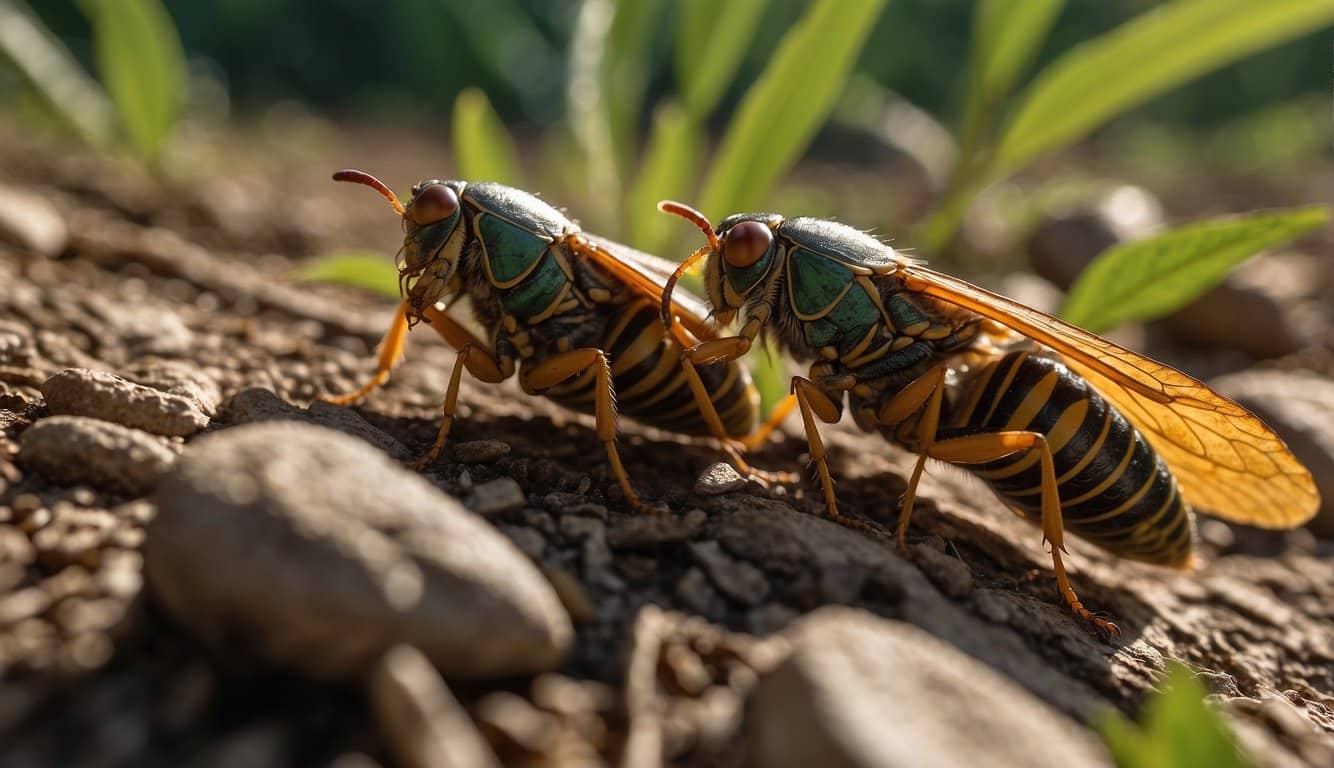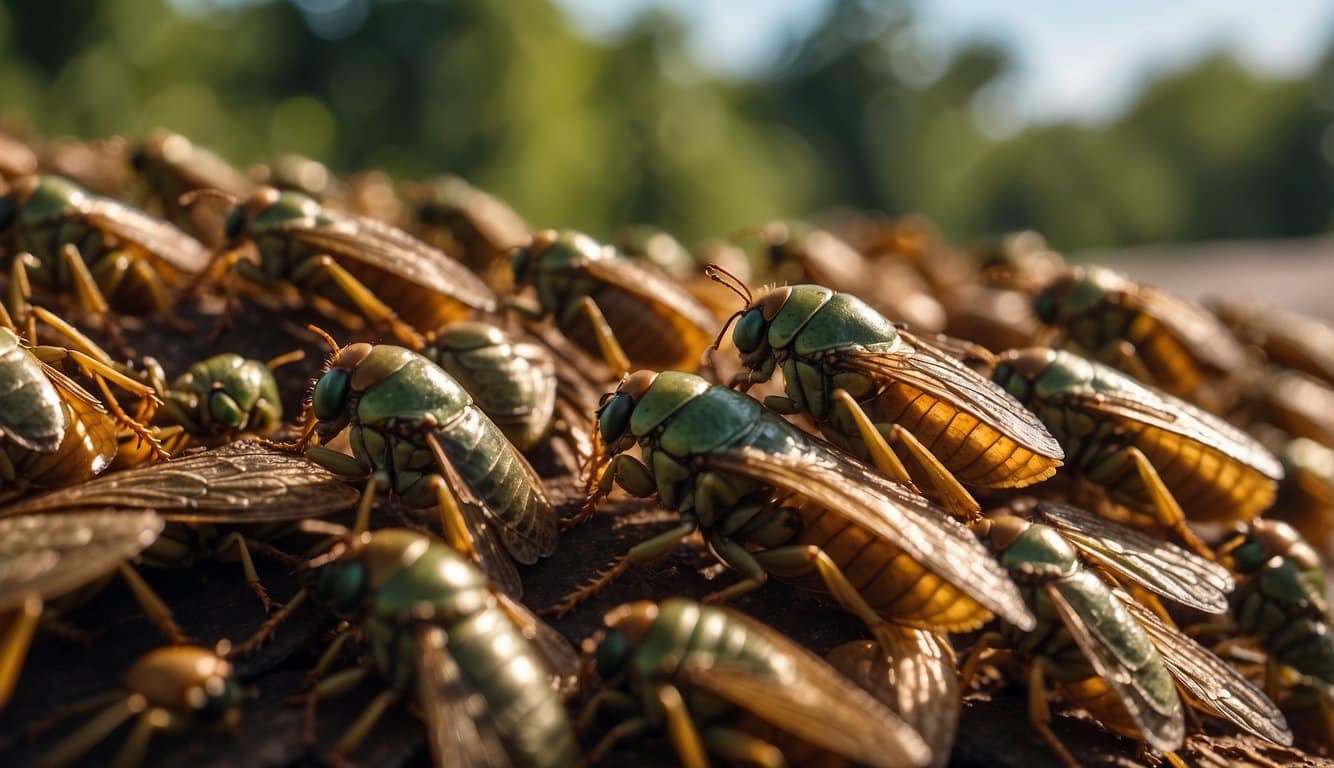Cicada Emergence in Missouri 2024
In 2024, your backyard in Missouri might be hosting an awe-inspiring natural concert as periodical cicadas emerge from the ground, transforming the landscape into a buzzing hub of activity.
If you’re curious about what to expect, here’s the scoop on this phenomenal event:
- Two Broods: This isn’t an ordinary emergence — it’s a double feature! You’re set to witness the simultaneous arrival of both 13- and 17-year cicada broods.
These neighbors rarely throw a joint party, but 2024 is the year they sync up for a dramatic debut.
- Widespread Phenomenon: Grab your binoculars because you won’t be the only spectator.
Missouri is one of 17 states where this fascinating occurrence will be visible. This event is truly remarkable, and you can discover where cicadas are emerging with handy maps.
- Infrequent Occurrence: Historical records suggest that these two broods last serenaded together back in 1803.
The next dual emergence isn’t due for another two centuries, so don’t miss out on this exclusive spectacle.
Here’s what you can do to prepare for their arrival:
- Mark Your Calendar: The emergence is expected to start in mid-May, where you’ll begin to see signs of their arrival as they dig their way to the surface.
- Educate Yourself: Learn more about this unique biological marvel through resources like the MU Extension guide, to better appreciate the event.
Species of Cicadas in Missouri
If you’re curious about cicada activity in Missouri for 2024, you’re in for an interesting year. This state hosts both periodical and annual cicadas, each with their own unique life cycles.
Periodical Cicadas
Missouri will witness the emergence of two major periodical cicada broods in 2024. Here’s the buzz:
- Brood XIX: Also known as the Great Southern Brood, it’s a 13-year cicada that were last seen in 2011. Experts predict they’ll be coming back to have their say across Missouri.
- Brood XIII: This less frequent, 17-year brood, is set to add to the choir, stepping into the limelight in parts of the state.
Annual Cicadas
Compared to their periodical cousins, annual cicadas are more of a yearly treat:
- Known for their distinctive green or black coloring and vibrant sound, they show up each summer to serenade you through the swelter.
- They’re more solitary but just as vocal, ensuring a steady stream of cicada music for your summer evenings.
Forecasting Cicada Activity
In 2024, your ears are in for a treat or a challenge, depending on how you feel about the symphony of cicadas. Missouri is a hotspot, where these periodic critters make their long-awaited appearance after years underground. Let’s get into the specifics of when and where you’re likely to encounter them.
Weather Dependency
Cicada emergence is heavily reliant on the right weather conditions; it’s all about the temperature for these insects.
Specifically, they require the soil to be around 64 degrees Fahrenheit at a depth of about 8 inches before making their grand entrance.
- Any significant changes in expected temperatures could shift their schedule, making them either early birds or fashionably late to the party.
- A warm trend as spring hits could see them popping up sooner, while a cool spell might push their timetable back.
Brood Mapping
Brood XIX, also known as the Great Southern Brood, has been mapped and is anticipated to emerge in Missouri. This mapping is invaluable as it gives you a heads-up on what to expect:
- Brood XIX – These cicadas are on a 13-year cycle and have chosen 2024 as their year to emerge and be seen, and more importantly, heard.
- Projected Areas – The emergence spots are projected to be widespread, gracing a significant part of the state.
Hotspots include:
- The Ozarks
- Central Missouri
- Parts of Northern Missouri
By paying close attention to cicada maps like the one featured on USA Today, you can plan your outdoor activities around these noisy but fascinating insects. If you’re keen on experiencing this natural phenomenon or perhaps eager to avoid it, keeping an eye on the weather and checking updated maps are your best bets.
Impact on Missourians
You’re in for a buzzy time! This year, your Missouri backyard is the front-row seat to a natural symphony as cicadas make their grand entrance after a 17-year underground hiatus. Here’s what you can expect:
- Soundtrack of Summer: The air will be filled with their distinctive chorus, which might be a bit overwhelming at times.
Some of you may find this hum to be a fascinating display of nature, while others might reach for earplugs.
- Gardening with Guests: Cicadas are mostly harmless to your plants, focusing on mating rather than munching.
However, young trees might need protection from the females’ egg-laying habits.
Nature’s Cleanup Crew:
- You can expect an increase in local wildlife that enjoys a cicada snack.
- You may spot more birds, raccoons, and even your pets showing interest in these protein-packed insects.
- After the cicadas have completed their lifecycle, their decomposing bodies will become a source of nutrients for your soil, contributing to a more fertile garden.
Community Buzz:
- Local events may capitalize on the cicada emergence, offering educational opportunities and creating themed activities.
- There may be temporary alterations to outdoor activities due to the increased insect activity.
- Adjust your plans accordingly, and why not join in the cicada conversation?
Quick Tips:
- Protect young trees with netting.
- Enjoy outdoor activities during cooler times when cicadas are less active.
- Embrace this unique experience—it won’t happen again for another 17 years!
Preparation and Response
When you’re gearing up for the cicada invasion in Missouri, a little readiness goes a long way. Here’s how you can respond effectively:
- Safety First: Cicadas are mostly harmless, but in rare cases, pets can overindulge.
- Monitor your furry friends outdoors to prevent them from eating too many.
- Shield Your Saplings: Young trees are vulnerable to cicada activity.
- Use netting with a mesh size no larger than 1/4 inch to protect new plantings.
For Your Outdoor Enjoyment:
- Stay Informed: Keep tabs on the expected cicada emergence areas.
- Cicada Soundtrack: Prep your playlists or earplugs to muffle their serenade.
- Event Planning: Hosting a BBQ? Maybe choose a weekend before or after peak emergence.
Maintenance Matters:
- Lawn Care: Mow regularly before they emerge, as cicadas often avoid short grass.
- Post-Cicada Cleanup: Anticipate raking up shed exoskeletons and potential debris from flagging.
Frequently Asked Questions
Cicadas are fascinating insects and if you’re in Missouri, you’re in for a treat in 2024. Discover when and where these periodic visitors will show up and what their appearance means for you.
When can we anticipate the emergence of cicadas in Missouri?
In 2024, you can expect the cicadas to make their appearance in Missouri as early spring transitions into summer. This is the time when soil temperatures reach about 64 degrees Fahrenheit, coaxing the cicadas to surface.
What areas of Missouri are expected to see cicada activity in 2024?
Many parts of Missouri will witness cicada activity, with a focus on areas where mature trees are abundant as these insects prefer wooded locations to lay their eggs.
How often do cicadas make an appearance in Missouri?
Cicadas emerge in Missouri in two cycles: every 13 or 17 years, depending on the brood. This means you’ll see them less often than the foliage changes, but when they arrive, they do so en masse.
Can we expect a large cicada emergence in St. Louis in 2024?
Yes, in 2024, St. Louis is one of the cities where a considerable emergence of cicadas is anticipated. Residents should prepare for a symphony of cicada sounds as they cloak the area.
Which years have historically seen significant cicada populations in Missouri?
Missouri has seen significant cicada populations in past years where the periodic broods emerge. For example, Brood XIX made a memorable appearance in previous cycles that correspond with their 13 or 17-year emergence pattern.
Will the pattern of cicada appearances continue past 2024 into 2025 and beyond?
Yes, the pattern of cicada appearances is expected to continue with various broods emerging at different intervals in the future.
Your next encounter will depend on which brood’s cycle is due.

